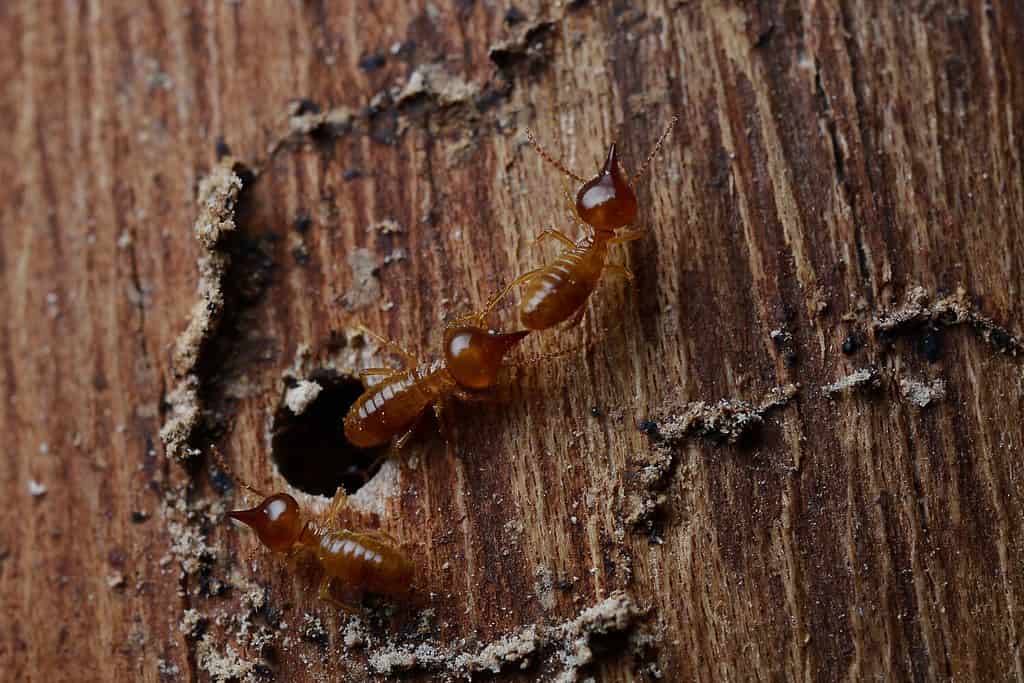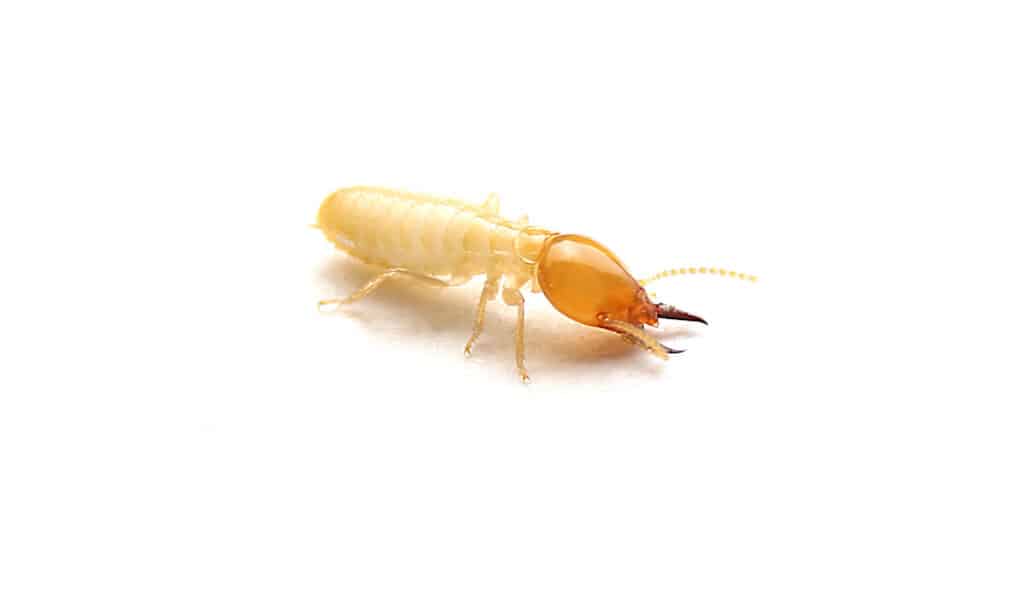Termites are famous for being one of the most annoying and hard-to-deal-with pests. While other pests can be harmful to homes, termites can cause major damage to the actual structure, leading to a dangerous living environment. Termite feast on wood as their main source of food as their bodies have the enzymes required to break down the cellulose found in wood! This can end up making your home their home as well! Due to their diets, termites can hollow out the structural foundation of a home, as well as ruin the furniture of the home. Getting rid of termites is essential to maintaining a safe living condition, and part of that is the identifying process! Keep reading below to learn more about the different colors and specifics of termites!
Termite Color Importance

Depending on a termite’s position in the colony, they may or may not have wings!
©galuhtati/Shutterstock.com
Identifying a termite is the first step to creating a safe and liveable home! The easiest way to quickly identify a termite species is by analyzing their colors! As will be discussed later, each termite species requires a unique treatment based on the kinds of wood they consume. Termites that consume dry wood cannot be treated the same as others, so it is important to know the different colors! Termite exterminators are skilled in their craft and can quickly identify different termite species, if you are curious about how they do it, keep reading!
Colors of Termites
Currently, there are 45 different kinds of termite species in the United States. While this number may be big, many termites share similar color patterns and need further physical examinations to correctly identify! Having a general basis to go off of, however, is beneficial to preventing any breakouts and starting treatments. The main colors of termites range from white, pale yellow, and orange, to even black. There are many colors and shades in between as well, often depending on the age of the termite as well! To understand what kind of troubles termites may be giving you, it’s best to learn about the species!
Black

Different termite species have their own unique burrowing pattern.
©Chaikom/Shutterstock.com
Black termites typically refer to the subterranean termite. These termites eat away at all woods, but are most commonly found within pine wood! These termites are most often found in northern regions, following the pine tree diet! While they prefer pine, they are capable of nesting in both dry and damp wood, making them dangerously versatile! It is important to maintain a clean structure with frequent checks. Unlike other termites, there is little signifying of an infestation, so it is up to the owner of a home to take proper care and prevention.
These termites are quickly identifiable as they are either completely black in color or dark brown. Some of the different types of subterranean termites have wings while some don’t. This makes them easily confused with ants at times. One way to tell is through the pattern of eating away at wood! Subterranean termites will leave a honeycomb-like appearance on their infestation areas, so be sure to watch out!
The easiest solution for these termites is through fumigation. Many subterranean termite nests don’t actually exist within the wood of the home as they nest underground. This can make it difficult to prevent them from coming in the first place. Having proper ventilation under the home is a great way to, but this is often not possible in older-built homes. The best way is to utilize chemicals to your advantage to prevent any trouble in the future!
Red/Brown

Some termites will nest in wood while some nest underground.
©phadpangpang/Shutterstock.com
The main suspect termite for this color is the dry wood termites. Drywood termites get their name from their diet and nesting habits. These termites infest any wood that is dryer in texture, for example, homes. Homes more often than not use dried wood as it can prevent bending and warping, especially in humid climates! This is, unfortunately, perfect for the dry wood termites who both eat away at this wood and nest in it as well.
Drywood termites have a red or brown body depending on their age and other factors. Their wings are sheer and white in appearance with visible veins! These are straightforward in identification but may require a keen eye, especially in a large nest. One identifying characteristic of these termites is the way in which they eat away at the wood. It is common for these termites to chew away in a smoother texture.
Treatments for dry wood termites rely on both heat and fumigation. These termites are pesky and are more often than not noticed too late. This can lead to a whole building infestation with structural damage that needs immediate repair! Self-treatments are not recommended as they can cause more harm than good, and the use of chemical fumigation is dangerous! A self-treatment in a partial infestation that is possible is removing specific sections of wood. By cutting off any room to grow, you can solve the problem before it gets too out of hand!
Yellow

Yellow termites can look almost sheer in appearance because of how light they get.
©iStock.com/witsawat sananrum
The most common, and one of the most pesty yellow termites, is the dampwood termite! Similar to the dry wood, the damp wood termite gets its name from the diet and nesting habits it has. These termites are a major problem in more humid environments and climates. A good amount of times, these termites will find already decaying wood that was prone to it anyway. The problem becomes personal when there are pipes with leaks in the home. Leaks are often unnoticeable if they are on the smaller side, and slow build-up of moisture can create the perfect environment for damp wood termites to thrive!
Dampwood termites are yellow in color. It can be quick to identify these termites, especially if they are on the brighter side. The body is either a tanner yellow to bright yellow, a bit duller in color than a bee for reference. The wings are sheer, similar to the dry wood. There are other termites of this color such as the soldier termite!
For small infestations, a very easy solution is to remove any access to water. A consistent water supply is ideal for termites to thrive, and without one, they will either die or leave. There are chemical treatments, but it is overall easier to just remove water! One other easy way is to remove any wood that may be too far gone from fixing. This quick solution helps to prevent any further spreading of termites while also keeping building integrity!
Other Termites
There are other common termite species that can cause damage to the home. One of these is the Formosan termite found all over the United States. This termite is one of the brown/black termites but is famous for its intense and aggressive behavior. One of the scary parts of this termite is that it can burrow its way through walls and into the wood on the inside of homes. Termites are naturally aggressive creatures, but this is to another level. It is important to be wary of the dangers that termites pose to humans. As previously mentioned, with the help of experts, proper chemical treatment can be utilized to prevent harm done by termites! By being careful with how you approach the termite problem, you can guarantee safety for your home and a long and beautiful stay there!
Summary
Termites can be scary creatures. They are aggressive and can cause great structural damage to any home. The way they eat away at wood can be dangerous to the residents of a home, so proper care is needed to treat an infestation! One of the easiest ways to treat an infestation is through proper identification! Each termite species is unique in behavior and treatments, so finding out the species through its physical appearance is the first step toward solving the problem. Through this article, the 3 main colors of termites were explained, and hopefully, this information can be useful during any unwanted problems!
The photo featured at the top of this post is © phadpangpang/Shutterstock.com
Thank you for reading! Have some feedback for us? Contact the AZ Animals editorial team.






